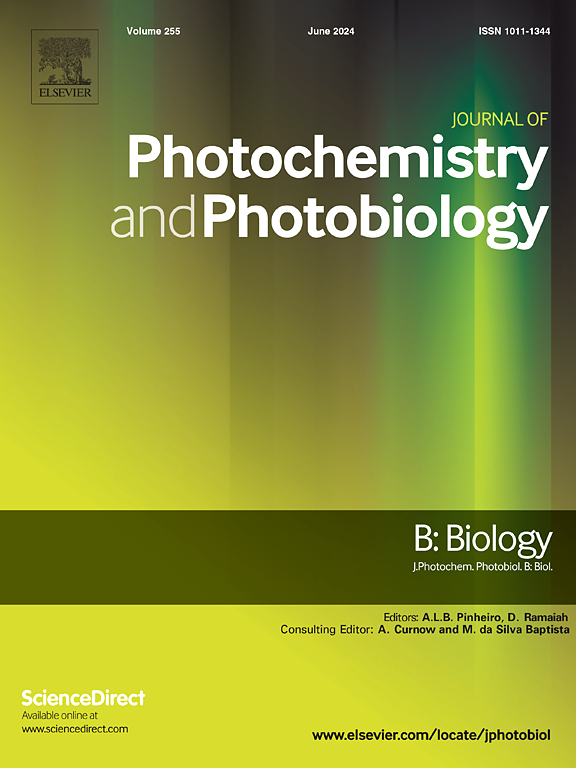“发光糖卟啉”:白色念珠菌灭活的光动力学方法
IF 3.9
2区 生物学
Q2 BIOCHEMISTRY & MOLECULAR BIOLOGY
Journal of photochemistry and photobiology. B, Biology
Pub Date : 2025-01-27
DOI:10.1016/j.jphotobiol.2025.113105
引用次数: 0
摘要
由于缺乏有效的抗真菌药物和耐药菌株的不断出现,侵袭性真菌病,特别是由白色念珠菌引起的侵袭性真菌病的发病率不断增加,是世界范围内一个相关的健康问题。光动力失活(PDI)是治疗耐药微生物引起的感染最有希望的治疗方法之一。开发具有合适性能的新型光敏剂是优化该疗法时需要考虑的关键因素。在这项工作中,我们设计、合成并表征了四种用s -半乳糖(乙酰化和去乙酰化)功能化的糖卟啉,并改变了叔氨基基的数量作为阳离子中心的前体,这些阳离子中心可以在生理ph下被质子化激活。引入氨基和糖基来增强与微生物细胞壁的相互作用,增加亲水性,并评估了它们对PS光失活效率的综合影响。所有衍生物均具有卟啉大环的吸收和发射特性。此外,糖卟啉还能生成单线态氧和超氧阴离子自由基。卟啉核上不同的取代模式对其光物理和光动力学性质没有影响。对白色念珠菌培养物进行PDI处理,用5 μM的PS处理并照射30分钟,对带阳离子中心的糖卟啉产生约3.5 log的细胞失活。此外,糖卟啉介导的白色念珠菌PDI被KI的加入增强。在这些条件下,观察到细胞死亡的显著增强,实现了处理细胞悬浮液的完全根除。此外,含有ph活化基团的糖卟啉与KI联用对白色念珠菌假菌丝有显著的抑制作用。这些体外研究结果强调了替代模式对抗菌作用的重大影响。据我们所知,这项研究标志着含有ph活化阳离子基团的糖基化卟啉衍生物首次应用于白色念珠菌的光失活,为开发具有有效抗真菌ps潜力的新型衍生物铺平了道路。本文章由计算机程序翻译,如有差异,请以英文原文为准。

“Illuminated Glycoporphyrins”: A photodynamic approach for Candida albicans inactivation
The continuous increase in the incidence of invasive mycoses, particularly those caused by Candida albicans, is a relevant health issue worldwide due to the lack of effective antifungals and the constant emergence of resistant strains. One of the most promising therapies to treat infections caused by resistant microorganisms is photodynamic inactivation (PDI). The development of novel photosensitizers (PSs) with suitable properties is a key factor to consider when optimizing this therapy. In this work, we designed, synthesized, and characterized four glycoporphyrins functionalized with S-galactose (acetylated and deacetylated) and varying the number of tertiary amino groups as precursors of cationic centers, which can be activated by protonation at physiological pH. The amino and glycosyl groups were introduced to enhance interaction with the microbial cell wall, increase hydrophilicity, and evaluate their combined effect on PS efficiency in photoinactivation. All derivatives presented the characteristic absorption and emission properties of the porphyrin macrocycle. Moreover, the glycoporphyrins were capable of generating singlet oxygen and superoxide anion radical. The photophysical and photodynamic properties were not affected by the different substitution patterns on the porphyrin core. PDI treatments of C. albicans cultures, treated with 5 μM of the PS and irradiated for 30 min, produced cellular inactivation of ∼3.5 log for glycoporphyrins with cationic centers. Furthermore, PDI of C. albicans mediated by glycoporphyrins was potentiated by the addition of KI. Under these conditions, a significant enhancement in cellular death was observed, achieving complete eradication of the treated cell suspensions. Moreover, glycoporphyrins containing pH-activable groups, combined with KI, showed outstanding efficacy against C. albicans pseudohyphae. These in vitro findings underscore the significant impact of substitution patterns on antimicrobial action. To our knowledge, this study marks the first application of glycosylated porphyrin derivatives containing pH-activatable cationic groups in the photoinactivation of C. albicans, paving the way for the development of novel derivatives with potential applications as effective antifungal PSs.
求助全文
通过发布文献求助,成功后即可免费获取论文全文。
去求助
来源期刊
CiteScore
12.10
自引率
1.90%
发文量
161
审稿时长
37 days
期刊介绍:
The Journal of Photochemistry and Photobiology B: Biology provides a forum for the publication of papers relating to the various aspects of photobiology, as well as a means for communication in this multidisciplinary field.
The scope includes:
- Bioluminescence
- Chronobiology
- DNA repair
- Environmental photobiology
- Nanotechnology in photobiology
- Photocarcinogenesis
- Photochemistry of biomolecules
- Photodynamic therapy
- Photomedicine
- Photomorphogenesis
- Photomovement
- Photoreception
- Photosensitization
- Photosynthesis
- Phototechnology
- Spectroscopy of biological systems
- UV and visible radiation effects and vision.

 求助内容:
求助内容: 应助结果提醒方式:
应助结果提醒方式:


